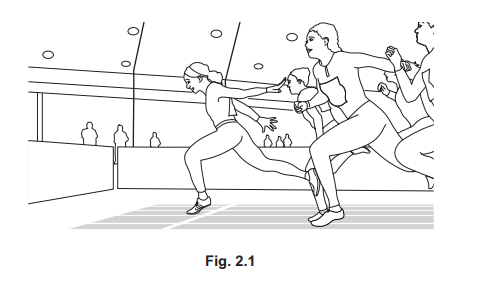Question
Fig. 2.1 shows an athlete crossing the finishing line in a race. As she crosses the finishing line, her speed is 10.0 m / s. She slows down to a speed of 4.0 m / s.

(a) The mass of the athlete is 71 kg. Calculate the impulse applied to her as she slows down.
impulse =………………………………………………………………………………………………………….
(b) (i) Define impulse in terms of force and time.
(ii) The athlete takes 1.2 s to slow down from a speed of 10.0 m / s to a speed of 4.0 m / s.
Calculate the average resultant force applied to the athlete as she slows down.
force =…………………………………………………………………………………………………………..
(c) Calculate the force required to give a mass of 71 kg an acceleration of 6.4 m / \(s^2\).
force =…………………………………………………………………………………………………………..
Answer/Explanation
Answer
(a) (impulse =) change of momentum
(impulse =) 71(10 – 4)
(impulse =) 430 N s
(b)(i)(impulse=)force×time
(ii) (av F =) impulse / time (= 430 / 1.2)
(av F =) 360 N
(c) F= ma in any form OR (F =) ma OR 71 × 6.4
(F=) 450 N
Question
Fig. 2.1 shows a wooden trolley of mass 1.2 kg at rest on the rough surface of a bench.

A ball of mass 0.52 g travels horizontally towards the trolley. The ball embeds itself in the wood of the trolley. The trolley moves with an initial speed of 0.065 m / s
(a) Calculate:
(i) the impulse exerted on the trolley
impulse =…………………………………………..
(ii) the speed of the ball as it hits the trolley.
speed =…………………………………………….
(b) As the trolley moves across the rough surface, it slows down and stops.
Explain, in terms of the work done, the energy change that takes place as the trolley slows down.
Answer/Explanation
Answer:
(a)(i) 0.078 N s or 0.078 kg m / s
(I =) \(m_t(Δ)v_t\) in any form or 1.2 × 0.065
(a)(ii) 150 m / s
\(v_b\) = \((m_t + v_t)\) / \(m_b\) in any form or initial momentum = final momentum
or 1.2(0052) × 0.065 / 0.00052 or 0.078(0338) / 0.00052
(b) work done against / due to / because of friction or kinetic energy (of trolley) used to do work
kinetic energy decreases (to zero)
thermal energy produced
